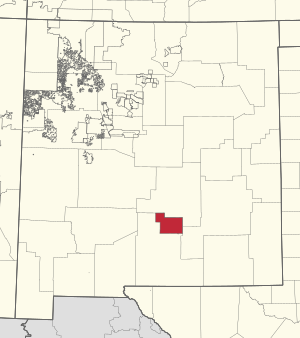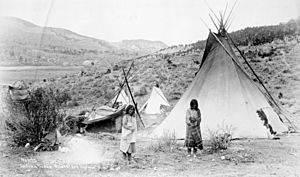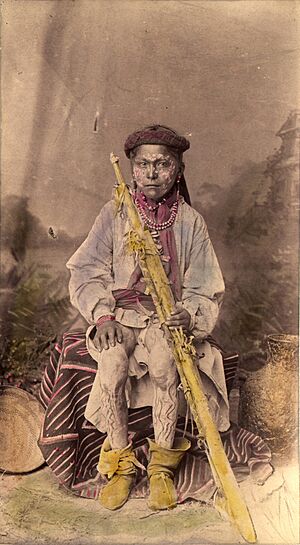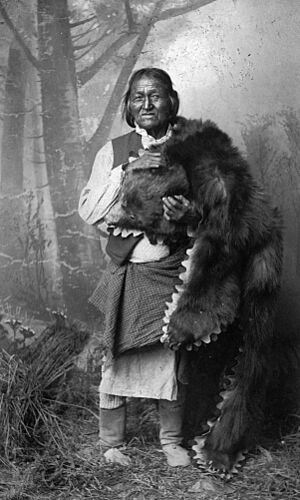Mescalero facts for kids
| Naa'dahéńdé (Mescalero-Chiricahua) | |
|---|---|

Location of Mescalero Apache Nation Reservation
|
|
| Total population | |
| 64,484 total Apache 8,652 MATReservation | |
| Regions with significant populations | |
| Languages | |
| Mescalero, English, Spanish | |
| Religion | |
| Catholic Religion, Mescalero and Native Cultural Heritage | |
| Related ethnic groups | |
| Western Apache, San Carlos Apache, White Mountain Apache, Navajo |
The Mescalero Apache (who call themselves Naa'dahéńdé) are a special group of Native Americans. They are part of the larger Apache family. The United States government officially recognizes them as the Mescalero Apache Tribe. Their home is on the Mescalero Apache Reservation in south-central New Mexico.
In the 1800s, the Mescalero people welcomed other Apache tribes, like the Mimbreno and Chiricahua, to their reservation. Some Lipan Apache people also joined them. Today, the descendants of these groups are part of the Mescalero Apache Tribe.
Contents
The Mescalero Apache Reservation

The Mescalero Apache Reservation was first created in 1873 by President Ulysses S. Grant. The reservation you see today was set up in 1883. It covers a large area of land, about 719 square miles, mostly in Otero County.
This beautiful land is on the eastern side of the Sacramento Mountains. It is next to the Lincoln National Forest. A main road, U.S. Route 70, runs through the reservation.
Economy and Tourism
The Mescalero tribal lands are known for their amazing scenery. Because of this, a big part of the tribe's economy comes from hotels and tourism. They also earn money from trading and ranching. The tribe is growing its technology sector with new innovation centers.
The Mescalero Department of Resource Management and Land Development has been very successful. In 2022, they celebrated 60 years of managing their resources well. They also marked 20 years since opening two popular tourist spots.
The Mescalero tribe designed, built, and owns the Inn of the Mountain Gods (IMG) Casino and Golf Resort. This resort is located within the Lincoln National Forest. They also designed, built, and run the Ski Apache Resort in the Sierra Blanca Mountains. This is the southernmost large ski resort in North America.
The tribe manages these places, including sports like horseback riding and zip lines. This shows their strong business sense and how tough they are. These resorts are top travel spots, known around the world. They combine Native American culture with modern resorts.
Cultural Centers and Sacred Mountains
The mountains and hills on the reservation are covered with pine trees. The Mescalero Apache Tribal Council carefully manages these natural resources. The tribe has a cultural center near their main office in the community of Mescalero. Here, you can see tribal artifacts and learn about their history.
They also have a bigger museum in Dog Canyon, south of Alamogordo. New museums are being planned to show how the Mescalero are involved in space innovation. They work with groups like the New Mexico Space Consortium and NASA.
The Ski Apache area is next to a huge mountain called Sierra Blanca. This mountain is about 12,003 feet tall. It is the southernmost tall mountain peak in the continental United States. Sierra Blanca Peak is a sacred place for the Mescalero Apache Tribe. You need a special permit to visit it.
Mescalero Culture and Language
The Mescalero language is a Southern Athabaskan language. It is very similar to the Chiricahua language. These are considered two of the three main Apache languages. While Navajo is related, its language and culture are different from the Apache.
The Mescalero Apache were mostly a nomadic mountain people. This means they moved around a lot. They were known as skilled and smart warriors. Their fighting methods are still studied today. Modern military aircraft, like the Apache helicopter, are even named after Native American groups.
The Mescalero traveled east to hunt buffalo on the plains. They went south into the desert to gather Mescal Agave. Spanish settlers called them "Mescalero Apache" because of this plant. The Mescalero Apache, like other Apache groups, lived by hunting animals and gathering plants. Their culture taught them to protect nature and use their resources wisely.
Daily Life and Family
Mescalero men led hunting trips for buffalo, antelope, and deer. Women helped prepare the meat and skins. They also hunted small animals like rabbits. Women gathered Mescal Agave in groups, often with friends and family. Men also helped process the mescal plant.
Family lines were traced through the mother's side (matrilineal). However, important male ancestors, especially famous warriors, were also remembered. Extended families included grandparents, unmarried children, and their married daughters' families. When a woman married, the couple would live near her parents' home in a new tipi or wickiup.
Origin of the Mescalero Name
The Mescalero call themselves Shis-Inday, which means "People of the Mountain Forests." Another name they use is Mashgaléńde, meaning "People close to the mountains." The Navajo, another related tribe, call them Naashgalí Dineʼé. Like other Apache groups, they often simply call themselves Ndé, meaning "The People."
Neighboring Apache groups called the Mescalero Nadahéndé, or "People of the Mescal." This is because the mescal agave plant was a very important food source for them. When food was scarce, they relied on stored mescal to survive. Today, they also identify as Naa'dahéńdé, which means "The People of the Mescal." Since 1550, Spanish colonists have called them Mescalero.
European settlers often used different names for Mescalero Apache groups. These names sometimes came from the areas where they lived. For example, they were called Sierra Blanca Apaches or Guadalupe Mountains Apaches based on their homelands.
Mescalero Tribal Territory
The different Mescalero groups originally lived in a large area. This land stretched from the Rio Grande in the west to parts of Texas in the east. It went from Santa Fe in the northwest down to the Big Bend area and into Mexico. This diverse land included tall mountains, sheltered valleys, dry deserts, deep canyons, and open plains. The Mescalero Apache Reservation is located at 33°10′42″N 105°36′44″W / 33.17833°N 105.61222°W.
Mescalero identity is rich with old stories. For example, four mountains are very important to their daily life:
- Sierra Blanca Peak (White Peak)
- El Capitan in the Guadalupe Mountains
- Three Sisters Mountain (Las Tres Hermanas)
- Oscura Mountain Peak (sometimes Salinas Peak is listed instead)
Their ancestors also spoke of a creator who gave them life on White Mountain. It was there that White Painted Woman gave birth to two sons, Child of Water and Killer of Enemies.
Each Mescalero group could use the deer and plants from neighboring areas. This meant they felt at home across their wide tribal lands. The Mescalero groups often traveled far for hunting, gathering, and sometimes for warfare or raids. They called their home Indeislun Nakah, meaning "place where people get together." Today, they call it Mashgalé-ne bikéyaa, or "Mescalero Apache Country."
Between 1700 and 1750, the Comanche people pushed many Mescalero groups out of the Southern Plains in Texas. The Mescalero then found safety in the mountains of New Mexico, western Texas, and parts of Mexico.
Mescalero Bands

The Mescalero were divided into several regional groups, or bands. European settlers and later Americans knew these bands by different names.
- Naa’dańde ("Mescal People"): These were the original Apache people who would become the Mescalero. They lived between the Rio Grande and Pecos River in New Mexico.
- Gułgahéńde ("People of the Plains"): These groups lived east of the mountains, on the High Plains from the Texas Panhandle to the Pecos Valley.
- Dził-í naańde ("Mountain Ridge Band People"): They lived in the mountains west and south of the Pecos River, extending into northern Mexico.
- Ch’ilaańde ("Antelope Band People"): These groups lived west of the Pecos to the Rio Grande in the mountains of central and south New Mexico.
- Nii’t’ahéńde ("People Who Live Against the Mountains"): Also called Sierra Blanca or Sacramento Mountains Mescaleros. Their main groups lived in the Sacramento Mountains and Sierra Blanca in New Mexico.
- Tséichíńde ("People of Red Rock"): Also known as Guadalupe Mountains Mescaleros. They lived in the Guadalupe Mountains and nearby plains of Texas and Mexico.
- Tsébikįnéńde ("Rock House People"): Also called Aguas Nuevas Apaches or Norteños. They were based around Nuevo Casas Grandes in Mexico and moved north towards the Sacramento Mountains.
- Tahuundé ("Mountains Extending into the River People"): They lived on both sides of the Pecos River in southern New Mexico and Texas.
- Chisos Apaches ("Forest People"): Also called Chinati Apaches or Rio Grande Apaches. This strong group lived in the Chihuahuan Desert and mountains on both sides of the Rio Grande.
- Túntsańde ("Big Water People"): Originally a Lipan Apache group, they joined the Mescalero and became a Mescalero band.
- Tú’édįnéńde ("No Water People"): Also originally a Lipan Apache group, they eventually joined some southern Mescalero bands.
The Naa’dahéńde had a lot of influence on some Western Lipan groups in the 1700s. To fight their common enemy, the Comanche, the Mescalero and their Lipan relatives often worked together.
In 1912, the U.S. Congress released the remaining members of the Chiricahua tribe from being prisoners of war. They could choose to stay at Fort Sill, Oklahoma, or move to the Mescalero Apache reservation. Many chose to go to New Mexico, and their descendants still live in both places today.
Notable Mescalero People
Over time, many important leaders and people have come from the Mescalero Apache Tribe.
Historical Chiefs and Headmen
- Barranquito (died 1857): A very important chief of the Sierra Blanca Mescalero band in the early 1800s. His sons and nephews, Santana, Cadete, and Roman, took over after him.
- Santana (about 1810–1876): Son of Barranquito and a powerful leader. He was known for being a friend to white settlers later in his life.
- Cadete (also known as Gian-na-tah – "Always Ready"): Another son of Barranquito and a very strong chief. He was a spokesperson for the northern Mescalero bands.
- Roman Grande: A son of Barranquito, less important than Santana and Cadete, but still a local group chief.
- Josecito: An important leader of some Sierra Blanca Mescalero groups. He signed a treaty with the U.S. in 1852.
- San Juan: Chief of the Sacramento Mountains Mescaleros. His band lived along the Rio Bonito and Rio Hondo. His son, Peso, would become the last Mescalero chief.
- Caballero: A war chief and later a main chief of the Sacramento Mountains Mescaleros. He was a close friend and ally of the great Mimbreño chief Victorio.
- Peso (about 1849–1929): Son of chief San Juan. He was an expert tracker and served as an Apache Scout against Geronimo. He became one of the main leaders on the reservation.
- Sin Miedo ("Without Fear"): Brother of chief Peso and son of chief San Juan. He also served as an Apache Scout.
- Muchacho Negro ("Black Boy", born about 1860, died 1930): An important local leader and war chief who joined Chief Victorio.
- Gorgonio: A medicine man who helped chiefs Barranquito and Santana.
- Alsate (about 1820–1881/1882): The last chief of the Chisos Apaches. He was known for leading raids and was eventually captured and executed in Mexico.
- Nautzili ("buffalo"): Chief of the Guhlkahéndé band. He moved to the reservation in 1876 and persuaded many warriors not to join Chief Victorio in his war.
Other Notable Mescalero
- Gouyen (about 1857–1903): A brave female warrior.
- Wendell Chino: Served as the tribal president of the Mescalero Apache Tribe for 43 years.
- Virginia Klinekole: The first female tribal president of the tribe.
- Sara Misquez: Also a former tribal president.
- Dr. Felicia Fontenot, DDS: The first Mescalero Apache Dentist.
- George Aguilar: An actor.
Education
Mescalero Apache Schools is the school system run by the tribe.
See also
 In Spanish: Mescalero para niños
In Spanish: Mescalero para niños


